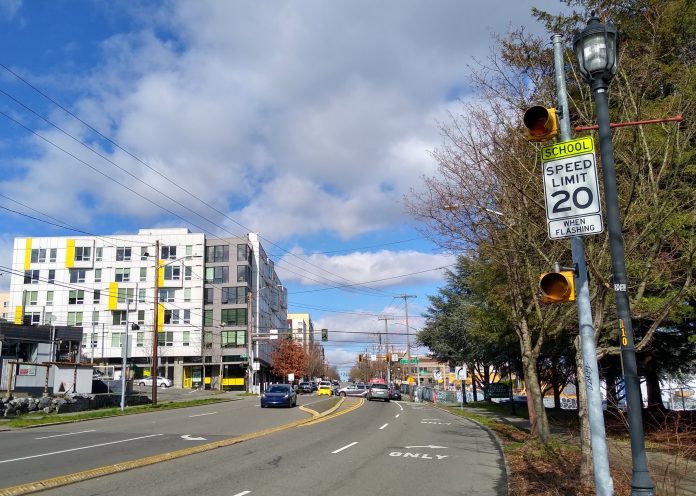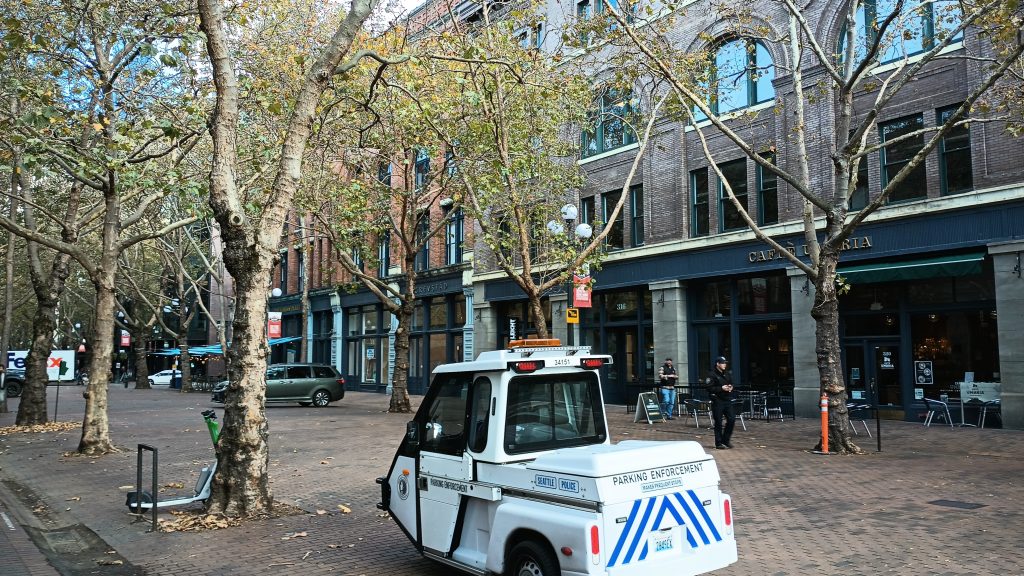
When Seattle City Council budget committee chair Teresa Mosqueda released a full slate of tweaks to Mayor Bruce Harrell’s proposed 2023-2024 budget early Monday morning, very few of the councilmember amendments adding Seattle Department of Transportation (SDOT) projects and programs made it into the final proposal. That’s largely due to a more pessimistic-than-anticipated revenue forecast earlier this month that sent the council into damage control mode. This morning The Urbanist covered how Mosqueda’s task of “delicately balancing” the final list of council priorities resulted in prioritization of spending like school health centers, abortion care, and cost-of-living increases for human services providers.
Many proposals, such as a $2.25 million expansion of the Home Zone program to improve traffic safety in neighborhoods that are currently lacking sidewalks or $2.5 million to get the Thomas Street “Redefined” corridor redesign back on track (after it was cut by Mayor Harrell), were left on the cutting room floor. Also dead is a proposal to tax bike and scooter share rides at 25 cents per ride, a proposal that would have cost about as much as it was expected to raise.
In fact, thanks to the incredibly gloomy revenue forecast, several essential transportation programs see significant cuts in SDOT’s two year budget as proposed, including a $4 million cut over two years to the city’s sidewalk safety repair program, and a $3.2 million cut to the bridge painting program. Those cuts join painful ones in other departments as well, including a $1.5 million cut to the Seattle Parks and Recreation’s Americans with Disabilities Act (ADA) compliance program.
But the package does propose to add two new sources of city revenue to support transportation, providing new resources for priorities important to many councilmembers while not impacting programs elsewhere in the budget. The most significant one of these is an increase of $10 to the city’s Vehicle License Fee (VLF), currently at $40. But rather than use this funding to backfill sidewalk repair, or bridge painting, the current proposal would use most of the funds generated in the first year of the increase to fund a priority of one councilmember.
Transportation chair Alex Pedersen, who proposed to increase the VLF in the first place, has been advocating for improvements to the NE 45th Street overpass in the U District, improvements that had originally included space for people biking but which have now been watered down to just barriers: fences and railings. SDOT cited pushback from Washington State Department of Transportation, with its traffic engineer fretting about freeway on-ramp queuing, for abandoning the uphill protected bike lane formerly under consideration. The $1.5 million currently earmarked for this would utilize over 75% of the funding gained from raising the VLF in 2023, with the remainder going to another Pedersen priority, bridge major maintenance, a separate program from bridge painting.
It’s not at all clear why $1.5 million should go toward one project in District 4, when more neglected areas of the city continue to bear the brunt of most of the traffic violence in the city, especially in the same budget that defunds the sidewalk safety repair budget by millions per year.

In 2024, the anticipated $4 million per year from the VLF increase would be split equally between bridge maintenance and Vision Zero safety improvements. That additional safety money joins $1.3 million allocated by the mayor for 2023, but an additional increase for next year as proposed by Councilmember Tammy Morales was left out of the package. Morales, who represents District 2 where the city continues to see an incredibly disproportionate share of traffic fatalities and serious injuries, is not satisfied with the status quo and is pushing for yet another amendment that would fund improvements to South End streets.
An amendment allocating $250,000 to pedestrian improvements around Ballard’s brewery district, requested by Councilmember Dan Strauss, and signed onto by Councilmember (and Fremont Brewing Company founder) Sara Nelson was prioritized in the budget ahead of any projects that specifically target Seattle’s most dangerous streets.
“I was very surprised that none of our proposed improvements [amending the budget] got added,” Morales said in an interview with The Urbanist Tuesday. She said that her office is still pushing to add a budget proviso holding funds within SDOT to add protected barriers to bike lanes in the South End, upgrading them from the existing paint-and-post material. The city has been adding sturdy barriers to projects like the Green Lake Outer Loop and Morales has been highlighting that imbalance. “The fact that even a proviso didn’t get in makes me really frustrated.”
City Moving Ahead With Doubling School Zone Speed Cameras
Another Pedersen proposal moving forward in the final package is a proposed doubling of the city’s school zone cameras. This will require an expenditure initially using funds that would be funding street improvements directly, instead directing $3.7 million to logistics that relate to expanding the camera program from 35 schools to 70 in advance of the 2023-2024 and 2024-2025 school years. Those 70 schools are described as a “minimum” number of new cameras.
The city doesn’t have a good estimate of how much revenue will actually be generated by the new cameras, currently estimating an incredibly conservative $1 million per year. Of course, the ultimate goal of the program should be to collect very little funding from the program as drivers obey the speed limit to improve safety around schools. In this way the planned expansion of the school zone camera program calls to mind the city’s Sweetened Beverage Tax, passed in 2017 with the intention of reducing consumption and now just one of a number of revenue sources that are sending the city scrambling when the forecast comes in lower-than-expected.
On Monday, Mosqueda emphasized some additional safeguards that the council is attempting to put on the camera program.
“We have also added, in conversation with the sponsor, specific language to address equity issues, so we are placing school zone cameras across the city,” Mosqueda said. “No longer will it be the case that there’s higher proportion of school zone safety cameras in especially communities of color. We want them equitably placed across the city and we have also directed the department to include language to have a grace period [of issuing warnings before official citations].”
By city ordinance, the funds generated from school zone cameras in Seattle are required to be reinvested in making safety improvements on school routes and in pedestrian safety. The state legislature recently authorized cities across the state to add cameras to places like hospital zones, parks, and school walk routes themselves (not just immediately outside the school), in addition to intersections that have a higher-than-average crash rate, but the city hasn’t signaled any interest in utilizing that authority. Those new cameras could be operated 24/7 and might lead to a more substantial behavior change than the school zone cameras, which are only on before and after school.
Parking Enforcement Stays With SDOT…For Now

A central question that the city council was grappling with this fall has been what to do about the city’s Parking Enforcement Unit, which had been transferred from the Seattle Police Department to the Seattle Department of Transportation, but essentially only in name, with many structures tying parking enforcement to SPD still in place. A major factor in this was a supposed lack of resources available to parking enforcement within SDOT, with many officers working long hours due to hiring shortages, and issues connecting parking enforcement with the data they used to have access to within SPD.
The proposed deal brokered between the mayor’s office and the council would keep parking enforcement within SDOT, allocating an additional $8.3 million in new funding, for additional hires (adding a proposed 88 officers and 12 supervisors), overtime, supplies, and new uniforms, which would apparently have an impact on morale. Breaking from their colleagues, Councilmembers Sara Nelson and Alex Pedersen voiced support for moving parking enforcement back to SPD and funding all of Mayor Harrell’s SPD budget asks (including the controversial ShotSpotter surveillance equipment) and already had an op-ed to that effect ready to roll in The Seattle Times on Monday.
Under the rebalanced budget, whether SDOT will be the permanent home for the parking enforcement or not will be left up to an interdepartmental team to figure out, with the timeline for that team to deliver a final report moved up to next April 15, a very quick turnaround. The direction to that team is a goal codified in city law that the final home of the unit should “bolster public trust and confidence in a reimagined system of community safety,” while maintaining the core responsibilities and mission of the unit. But politics may ultimately win out over all other arguments.
The mayor’s signal that he prefers parking enforcement to stay at SPD is a clear break from the hard fought concession won from the 2020 protests and backed by a broad coalition led by Decriminalize Seattle and King County Equity Now. The op-ed from Nelson and Pedersen suggests they’d rather relitigate the “defund” slogan and cast blame on their colleagues over having an honest conversation about how to best operate parking enforcement. Having SDOT in charge of parking enforcement might actually improve outcomes from a public safety standpoint and help them create more efficient use of limited street space, as The Urbanist’s Patrick Taylor has argued.
Major changes to the budget aren’t expected before a final vote next week, but there could be some final tweaks that reduce some of the pain that will be felt by the cut of some essential SDOT services. The city is currently banking on a quick recovery to get revenues back on track, but throwing basic sidewalk repair, bridge painting, and ADA improvements over the side isn’t a great signal of things to come.
Ryan Packer lives in the Summit Slope neighborhood of Capitol Hill and has been writing for the The Urbanist since 2015. They report on multimodal transportation issues, #VisionZero, preservation, and local politics. They believe in using Seattle's history to help attain the vibrant, diverse city that we all wish to inhabit. Ryan's writing has appeared in Capitol Hill Seattle Blog, Bike Portland, and Seattle Bike Blog, where they also did a four-month stint as temporary editor.




